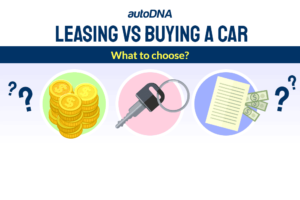
20/4/10 Rule – What Is Car Buying Rule?
Table of Contents
Table of Contents
When buying a car, navigating the sea of financing options, monthly payments, and down payments can feel overwhelming. To bring clarity to the process, the 20/4/10 car buying rule offers a simple yet effective guideline to ensure you don’t overspend and maintain financial stability.
What Is the 20/4/10 Car Buying Rule?
The 20/4/10 rule is a simple and effective financial guideline that helps car buyers make informed decisions about purchasing a vehicle. It is designed to promote financial stability and prevent individuals from overextending their budgets when buying a car. The rule encourages responsible spending by setting clear parameters for down payments, loan terms, and monthly expenses.
The 20/4/10 rule is broken down into three key components:
- 20% Down Payment
- 4-Year Loan Term
- 10% of Monthly Income
How to Apply the 20/4/10 Rule?
Step 1: Save for a 20% Down Payment
The first step in the 20/4/10 rule is to save at least 20% of the car’s price for a down payment. This upfront payment plays a crucial role in making the car purchase more financially manageable. By putting down 20%, you significantly reduce the total amount you need to finance, which directly lowers your monthly payments and the overall interest paid on the loan.
This approach also protects you from the immediate depreciation that cars experience, especially during the first few years of ownership. A substantial down payment ensures you won’t find yourself “upside-down” on the loan—owing more than the car’s current market value.
Additionally, a 20% down payment demonstrates financial responsibility, which can make lenders more likely to offer favorable terms, such as lower interest rates. Starting with equity in the vehicle from day one also gives you greater financial security, especially if you decide to sell or trade the car in the future.
To achieve this goal, it’s essential to plan and save effectively.
Begin by determining how much you can afford to spend on a car and calculate 20% of that amount.
Step 2: Limit Loan Terms to 4 Years
One of the key principles of the 20/4/10 rule is limiting the car loan term to no more than four years. This recommendation is designed to protect buyers from the financial risks that come with long-term loans, such as paying excessive interest or owing more than the car’s depreciated value.
When a loan stretches beyond four years, the monthly payments may appear more affordable, but the overall cost of the car increases significantly due to the additional interest paid over time. Longer loan terms often result in buyers paying far more than the vehicle’s initial value, turning what might seem like a good deal into a financial burden.
Keeping the loan term at four years ensures that buyers pay off their car faster, reducing the risk of becoming “upside-down” on their loan.
Being upside-down means owing more than the car is worth, which can be a serious issue if you need to sell or trade in the vehicle before the loan is fully paid off.
Cars depreciate quickly, especially in the first few years, so shorter loan terms help align the repayment period with the car’s declining value.
Additionally, a four-year loan term provides greater financial flexibility. With the car paid off sooner, you free up money in your budget for other financial priorities, such as saving for emergencies, investing, or reducing other debts. It also allows you to avoid being tied to a car loan for an extended period, giving you the option to upgrade or switch vehicles without the lingering burden of long-term debt.
To adhere to this guideline, it’s important to choose a car that fits comfortably within your budget. If the monthly payment for a four-year loan feels too high, it might be a sign to consider a less expensive car or increase your down payment. By sticking to a shorter loan term, you ensure a more manageable, cost-effective approach to car ownership and protect yourself from the financial pitfalls of long-term financing.
Step 3: Keep Car Costs Under 10% of Monthly Income
To maintain financial stability, it’s crucial to ensure that your car-related expenses do not exceed 10% of your monthly income. This percentage includes all costs associated with owning a car, such as your monthly loan payment, insurance, fuel, maintenance, and registration fees. By keeping these expenses within this limit, you can balance the cost of transportation without compromising other essential areas of your budget.
For example, if your monthly income is $4,000, aim to keep total car costs under $400.
Sticking to this guideline not only helps you avoid financial strain but also allows you to save for unexpected car repairs or other emergencies, ensuring that your vehicle remains a reliable and affordable part of your lifestyle.
Why Is the 20/4/10 Rule Useful?
The 20/4/10 rule is an invaluable tool for car buyers because it helps ensure financial stability and long-term affordability when purchasing a vehicle. Cars are depreciating assets, meaning they lose value over time, often significantly within the first few years. This makes it crucial to approach car ownership with a clear and disciplined strategy, and the 20/4/10 rule provides exactly that.
By requiring a 20% down payment, the rule reduces the amount borrowed, which in turn lowers monthly payments and the total interest paid over the life of the loan. A significant down payment also prevents buyers from being “upside-down” on their loans, where they owe more than the car is worth. This is especially important if the car needs to be sold or traded in unexpectedly.
Limiting the loan term to 4 years ensures that the car is paid off quickly, reducing the risk of excessive interest accumulation. Longer loan terms might seem attractive due to smaller monthly payments, but they often result in buyers paying significantly more for the car over time. By keeping the term short, buyers can align their repayment period with the car’s usable lifespan, avoiding the financial strain of still making payments on an older, depreciated vehicle.
Capping total car expenses at 10% of gross monthly income ensures that the vehicle remains an affordable part of the buyer’s overall budget. This includes not just the loan payment but also insurance, fuel, and maintenance costs.
Adhering to this limit leaves room for other financial priorities, such as savings, investments, housing, and everyday expenses. It also helps buyers avoid the common pitfall of overspending on a car, which can lead to long-term financial stress.
Overall, the 20/4/10 rule encourages a balanced approach to car ownership. It protects buyers from overcommitment, keeps debt manageable, and promotes smart financial habits. By following this rule, car buyers can enjoy the benefits of vehicle ownership without jeopardizing their broader financial goals.
Example of the 20/4/10 Car Buying Rule in Action
Let’s apply the 20/4/10 rule to a practical scenario:
- Car Price: $30,000
- Gross Monthly Income: $5,000
Step 1: Save 20% for Down Payment
20% of $30,000 = $6,000
This reduces the loan amount to $24,000.
Step 2: Finance for 4 Years
Assume a 5% interest rate over 48 months. The monthly loan payment would be approximately $552.
Step 3: Ensure Total Costs Stay Under 10% of Income
10% of $5,000 = $500
To meet the 10% rule, additional costs like insurance and fuel should not exceed $500 – $552 = $52. This signals that the $30,000 car exceeds the budget under this rule, so the buyer might need to consider a less expensive car.
Adjusting the Purchase:
- Consider a car priced at $25,000
- Down payment: 20% of $25,000 = $5,000
- Loan payment for $20,000 over 4 years at 5% interest = $460/month
This adjustment ensures total costs remain under 10% of the buyer’s income.
Conclusion: A Rule for Car Buying That Keeps Auto Loans and Car Payments Manageable
The 20/4/10 rule simplifies the car buying process by providing a clear framework to manage total car costs responsibly. It emphasizes saving for a 20% down payment, limiting auto loans to four years, and keeping total transportation costs, including car insurance and car payments, within 10% of your gross income. By following this rule, buyers can confidently navigate the car dealership and make informed decisions about how much car they can afford.
This approach not only helps control the purchase price but also ensures that your vehicle fits comfortably within your budget, leaving room for other financial priorities. Whether you’re a first-time buyer or experienced with the car buying process, this rule is a reliable strategy for achieving long-term financial stability and avoiding the stress of excessive debt.
By applying the 20/4/10 rule, you can make smarter decisions about your auto loan and overall car payment plan. A key element of the rule is making a higher down payment, ideally 20% of the car’s purchase price. This reduces the amount you need to borrow, helping you secure a smaller auto loan and saving you money in the long run by lowering interest costs. Additionally, committing to a shorter loan term ensures you pay off your car faster, giving you financial freedom and the opportunity to save money for other priorities.
At autoDNA.com, the market-leading VIN decoding tool, you can free VIN lookup on a given vehicle. All you need for this is the VIN number. In the reports, on used cars, you can find information that will allow you to check whether the seller is telling the truth or not. In the report, you can find data on various topics. One of them is the vehicle history or stolen vehicle bases. You can do a VIN check for free 24/7 throughout the year.
Does this rule apply to used cars?
Absolutely. In fact, the rule can be even more beneficial for used cars, as their depreciation rate is slower than new cars.
What if my income fluctuates?
If your income varies, base the 10% rule on your lowest estimated income to avoid financial strain during slower months.
What are the benefits of a larger down payment?
A larger down payment reduces your loan amount, monthly payments, and interest costs, providing greater financial flexibility.
Is leasing compatible with the 20/4/10 rule?
Leasing generally doesn’t align with the rule since it often requires smaller upfront costs but could result in higher long-term expenses. By following the 20/4/10 rule, car buyers can make smarter, more sustainable choices while protecting their financial health.











